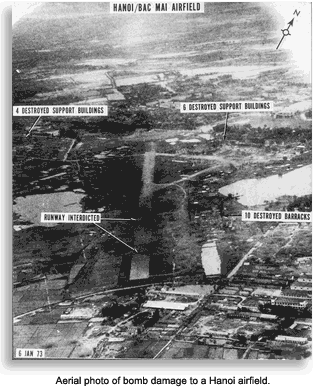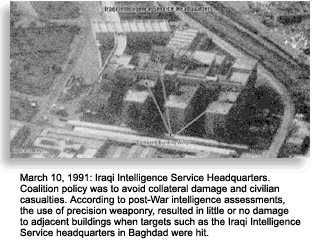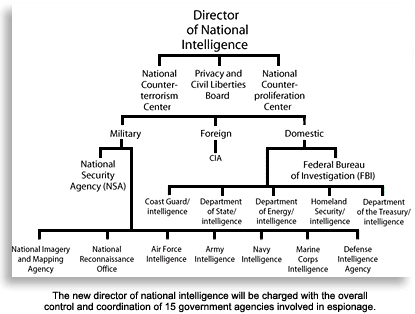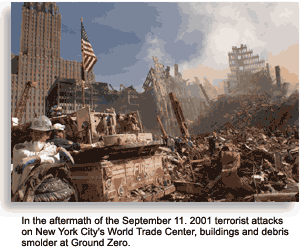When asked about intelligence gathering in the United States, people usually think of the Central Intelligence Agency (CIA). Those more knowledgeable about activities in this area might name also the Defense Intelligence Agency (DIA), the National Security Agency (NSA) and the National Reconnaissance Office (NRO). In fact, there is a wide array of entities, including many government agencies, that together make up what is termed the "intelligence community."
In 1961, the United States first orbited its Satellite and Missile Observation System, a photographic-reconnaissance satellite apparently designed for the express purpose of locating and monitering Soviet intercontinental ballistic missile sites. Since then, the United States and other nations have launched photoreconnaissance satellites on a regular basis. Other reconnaissance satellites include "ferrets", which eavesdrop on electronic signals undetectable from ground stations, and satellites that identify missile launches through infrared sensing.
Intelligence during the Vietnam War
Most military historians say that there was far from a lack of intelligence during the Vietnam War. On the contrary, they feel that there was too much information, and too few people who knew what it meant and how to use it.
By 1966, a great amount of intelligence information was reaching analysts concerned with Vietnam, Laos, and Cambodia. So much information, in fact, that it was a challenge to separate the wheat from the chaff, to wade through mountains of information for the wheat germ.
The problems the military intelligence community faced in Southeast Asia were overwhelming. There were no satellites, and communications intelligence was often limited by the terrain in Vietnam and the low power of the enemy's transmitters.
 The United States inflicted far more casualties than it suffered in Vietnam, and it practically never lost a conventional battle, but despite this, victory was never particularly close. One reason for this was the extraordinary tenacity of the other side, which lost multitudes of soldiers, but kept on fighting. Another reason is that the other side better understood the nature of intelligence war, in which information, political organization, the ability to hide, and selective strikes are the factors that matter most.
The SIGINT (signal intelligence) war in Vietnam included the interception of North Vietnamese radio traffic, which clearly indicated Hanoi's control of the war in the South. The North Vietnamese, however, had been running a huge SIGINT operation against the United States, with as many as 5,000 intercept operators listening in on American communications.
Many key decisions on the Vietnam War occurred during President Lyndon B. Johnson's first two years in the White House, among them the decision to pursue covert operations against North Vietnam, to send American combat troops to South Vietnam, to intervene on a massive scale with ground forces, as well as the decision to initiate a bombing campaign against North Vietnam.
Intelligence during the Persian Gulf War (Operation Desert Storm)
The Persian Gulf War began in August 1990, when Iraqi forces invaded and occupied Kuwait. In November 1990, President George H.W. Bush announced a military buildup to provide an offensive option named “Operation Desert Storm” to force Iraq out of Kuwait. Preparation for the operation took two and a half months, and involved a massive air and sea lift. In January 1991, the U.S. Congress voted to support the use of all necessary means if Iraq did not withdraw from Kuwait by January 15. The United States worked to establish a broad-based international coalition to confront Iraq. President Bush waited two days after the deadline for Iraqi withdrawal from Kuwait before ordering the coalition to begin action against Iraq. Baghdad was bombed fiercely by the coalition’s fighter airplanes in the first night of the war. What was unknown to them was that several weeks prior to that, U.S. intelligence agents successfully inserted a computer virus into Iraq’s military computers. That virus was designed to disable much of Baghdad’s air-defense system.
The United States inflicted far more casualties than it suffered in Vietnam, and it practically never lost a conventional battle, but despite this, victory was never particularly close. One reason for this was the extraordinary tenacity of the other side, which lost multitudes of soldiers, but kept on fighting. Another reason is that the other side better understood the nature of intelligence war, in which information, political organization, the ability to hide, and selective strikes are the factors that matter most.
The SIGINT (signal intelligence) war in Vietnam included the interception of North Vietnamese radio traffic, which clearly indicated Hanoi's control of the war in the South. The North Vietnamese, however, had been running a huge SIGINT operation against the United States, with as many as 5,000 intercept operators listening in on American communications.
Many key decisions on the Vietnam War occurred during President Lyndon B. Johnson's first two years in the White House, among them the decision to pursue covert operations against North Vietnam, to send American combat troops to South Vietnam, to intervene on a massive scale with ground forces, as well as the decision to initiate a bombing campaign against North Vietnam.
Intelligence during the Persian Gulf War (Operation Desert Storm)
The Persian Gulf War began in August 1990, when Iraqi forces invaded and occupied Kuwait. In November 1990, President George H.W. Bush announced a military buildup to provide an offensive option named “Operation Desert Storm” to force Iraq out of Kuwait. Preparation for the operation took two and a half months, and involved a massive air and sea lift. In January 1991, the U.S. Congress voted to support the use of all necessary means if Iraq did not withdraw from Kuwait by January 15. The United States worked to establish a broad-based international coalition to confront Iraq. President Bush waited two days after the deadline for Iraqi withdrawal from Kuwait before ordering the coalition to begin action against Iraq. Baghdad was bombed fiercely by the coalition’s fighter airplanes in the first night of the war. What was unknown to them was that several weeks prior to that, U.S. intelligence agents successfully inserted a computer virus into Iraq’s military computers. That virus was designed to disable much of Baghdad’s air-defense system.
 Operation Desert Storm employed a wide variety of new space and intelligence assets to ease mission planning, command and control the air war, provide real-time identification of ground targets for aircraft, and assure that the coalition gained and maintained the initiative.
Tactical digital facsimile was critical to crews and commanders during Desert Storm. It provided the capability to send high resolution pictures and other data, which proved to be secure, reliable, and vital to combat success. Tactical digital facsimile was today’s telephone to the modern battlefield commander.
Almost every aspect of naval command and control communications capability was stressed to the limit during Desert Storm. The volume of communications traffic, as well as a large percentage of the message traffic, presented a communications challenge of previously unimagined proportions. Portable communications vans and high speed modems stood out among the many systems that contributed to success.
The conflict culminated in fighting in January and February 1991 between Iraq and an international coalition of forces led by the United States. By the end of the war, the coalition had driven the Iraqis from Kuwait.
Intelligence today
The United States intelligence community consists of 15 components. The principal agency for intelligence activities and covert operations abroad is the Central Intelligence Agency, or CIA. Until recently, the Director of Central Intelligence (DCI) oversaw all U.S. intelligence, and served as the principal intelligence adviser to the president, in addition to serving as head of the CIA.
Operation Desert Storm employed a wide variety of new space and intelligence assets to ease mission planning, command and control the air war, provide real-time identification of ground targets for aircraft, and assure that the coalition gained and maintained the initiative.
Tactical digital facsimile was critical to crews and commanders during Desert Storm. It provided the capability to send high resolution pictures and other data, which proved to be secure, reliable, and vital to combat success. Tactical digital facsimile was today’s telephone to the modern battlefield commander.
Almost every aspect of naval command and control communications capability was stressed to the limit during Desert Storm. The volume of communications traffic, as well as a large percentage of the message traffic, presented a communications challenge of previously unimagined proportions. Portable communications vans and high speed modems stood out among the many systems that contributed to success.
The conflict culminated in fighting in January and February 1991 between Iraq and an international coalition of forces led by the United States. By the end of the war, the coalition had driven the Iraqis from Kuwait.
Intelligence today
The United States intelligence community consists of 15 components. The principal agency for intelligence activities and covert operations abroad is the Central Intelligence Agency, or CIA. Until recently, the Director of Central Intelligence (DCI) oversaw all U.S. intelligence, and served as the principal intelligence adviser to the president, in addition to serving as head of the CIA.
 In December, 2004, as a result of recommendations in the report by the House-Senate Intelligence Committee investigating the September 11, 2001 terrorist attacks, Congress passed the National Intelligence Reform Act, creating a Cabinet-level post of Director of National Intelligence as a new layer of authority over all U.S. intelligence (including the CIA), establishing a counter-terrorism center, and attempting to enhance communication among the various branches and agencies of the government. As a result of the Act, the director of the CIA will now be responsible for that agency alone.
The National Security Agency (NSA), established in 1952 by President Truman, is responsible for collecting signals intelligence (SIGINT) from all over the world and for overseeing American secret communications. Some sources suggest that there is a third highly secret national intelligence agency responsible for satellite surveillance. Other members of the American intelligence community include, among others, the Defense Intelligence Agency, which provides military intelligence to the Department of Defense, and the Federal Bureau of
Investigations, which provides counterintelligence activities within the United States.
Together, the 15 U.S. intelligence entities provide a broad range of support. They advise defense policymakers on political and military matters, major acquisitions, and force planning. They provide threat predictions that guide the military services in how best to "organize, train, and equip" their forces, and warn of potential crises. Finally, they support the employment of the armed forces across a broad range of operations, from disaster relief, to peacekeeping, to combat operations. The principal consumers of such information are U.S. combat forces, the military departments, the secretary of defense, and the president, but others responsible for foreign policymaking often have need for such information as well.
Collecting intelligence through human sources (HUMINT) has been undertaken by elements of military intelligence throughout its history. Recently, military HUMINT activities have included intelligence-gathering by military personnel, collection by special elements in advance of the deployment of U.S. military forces, and the recruitment of human sources by military personnel.
The NSA’s main building contains about 1.9 million square feet of floor space. It has employed more than 90,000 people, classifies about 50 million to 100 million documents a year, and has an annual budget of approximately $10 billion. The NSA is the biggest employer of mathematicians in the United States. The NSA handles code making, breaking, and protecting, and also is responsible for collecting and analyzing COMINT, SIGINT, and ELINT (electronics intelligence).
In December, 2004, as a result of recommendations in the report by the House-Senate Intelligence Committee investigating the September 11, 2001 terrorist attacks, Congress passed the National Intelligence Reform Act, creating a Cabinet-level post of Director of National Intelligence as a new layer of authority over all U.S. intelligence (including the CIA), establishing a counter-terrorism center, and attempting to enhance communication among the various branches and agencies of the government. As a result of the Act, the director of the CIA will now be responsible for that agency alone.
The National Security Agency (NSA), established in 1952 by President Truman, is responsible for collecting signals intelligence (SIGINT) from all over the world and for overseeing American secret communications. Some sources suggest that there is a third highly secret national intelligence agency responsible for satellite surveillance. Other members of the American intelligence community include, among others, the Defense Intelligence Agency, which provides military intelligence to the Department of Defense, and the Federal Bureau of
Investigations, which provides counterintelligence activities within the United States.
Together, the 15 U.S. intelligence entities provide a broad range of support. They advise defense policymakers on political and military matters, major acquisitions, and force planning. They provide threat predictions that guide the military services in how best to "organize, train, and equip" their forces, and warn of potential crises. Finally, they support the employment of the armed forces across a broad range of operations, from disaster relief, to peacekeeping, to combat operations. The principal consumers of such information are U.S. combat forces, the military departments, the secretary of defense, and the president, but others responsible for foreign policymaking often have need for such information as well.
Collecting intelligence through human sources (HUMINT) has been undertaken by elements of military intelligence throughout its history. Recently, military HUMINT activities have included intelligence-gathering by military personnel, collection by special elements in advance of the deployment of U.S. military forces, and the recruitment of human sources by military personnel.
The NSA’s main building contains about 1.9 million square feet of floor space. It has employed more than 90,000 people, classifies about 50 million to 100 million documents a year, and has an annual budget of approximately $10 billion. The NSA is the biggest employer of mathematicians in the United States. The NSA handles code making, breaking, and protecting, and also is responsible for collecting and analyzing COMINT, SIGINT, and ELINT (electronics intelligence).
 Some have said that the terrorist attack on America — September 11, 2001 — was the single greatest failure of American intelligence since Pearl Harbor. The attack on the World Trade Center killed several thousand people, destroyed billions of dollars’ worth of property, pushed the United States into recession, cast the nation into a foreign war, precipitated a political crisis throughout the Middle East, and shattered the confidence of American citizens.
The 2003 invasion and occupation of Iraq by the United States was the result of what is probably the most obvious case of the misreading of secret intelligence information in American history. The George W. Bush administration made three interlocking claims:
Some have said that the terrorist attack on America — September 11, 2001 — was the single greatest failure of American intelligence since Pearl Harbor. The attack on the World Trade Center killed several thousand people, destroyed billions of dollars’ worth of property, pushed the United States into recession, cast the nation into a foreign war, precipitated a political crisis throughout the Middle East, and shattered the confidence of American citizens.
The 2003 invasion and occupation of Iraq by the United States was the result of what is probably the most obvious case of the misreading of secret intelligence information in American history. The George W. Bush administration made three interlocking claims: